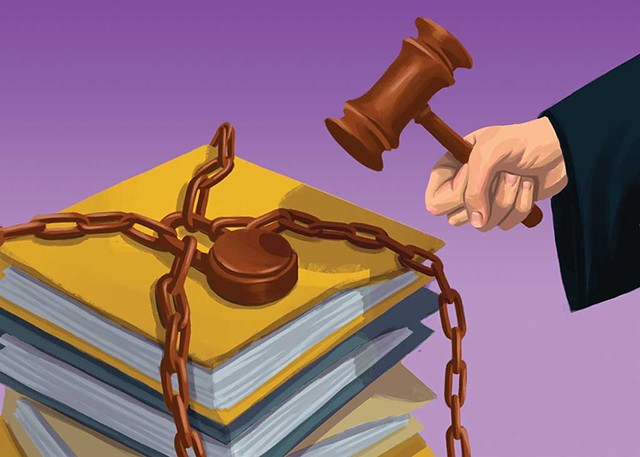
- Andrew Mulhearn
A Vermont judge has ordered a Rutland-area school district to release documents related to its use of restraint and seclusion of students. If upheld, the ruling could have broad implications for the types of school records that are available for public scrutiny.
The Slate Valley Unified School District board voted last week to appeal the December 4 decision handed down by retired Superior Court Judge Mary Miles Teachout, who was specially assigned to the case. The ruling stems from a lawsuit filed by school board member Curtis Hier, who has rankled administrators and fellow board members for months with a deluge of Freedom of Information Act requests, calls for an investigation of the superintendent and adversarial Facebook posts.
Hier, a former high school teacher in the district who is representing himself in the suit, said he requested the restraint and seclusion forms in September after parents, former employees and current staffers told him that children had been mistreated. Former special educator Jami Sherwood, for one, told Seven Days that she resigned several years ago from Fair Haven Grade School after witnessing a teacher use her nails to claw a student's hands off a tricycle. Another time, Sherwood said, a child was secluded in a locked classroom for hours.
Hier's lawsuit sought the release of what are known as 4500 forms dating back to 2015. The forms refer to State Board of Education Rule 4500, which says restraint — or holding a student to restrict their movement — and seclusion — placing a student in a space from which they are prevented from leaving — should be used only when students pose a danger to themselves or others.
Under state law, school districts must document the incidents on forms that include the student's name, the type of restraint or seclusion employed, the reason for its use, and a description of the "behavioral interventions" tried before resorting to either.
Hier initially requested the forms during the summer through several public record requests, but the school district denied them.
Judge Teachout's ruling calls on the district to release all Rule 4500 forms from January to April 2021, any from between 2015 and 2021 in which the "Blue Room" or a "calm down space" is mentioned, and any concerning a specific special-education teacher in the district.
Student names, ages, gender and other identifying information must be redacted before the documents are released, the order says, as do students' special-education status and other information regarding behavioral or education support plans.
In her ruling, Teachout rejected the school district's position that the restraint and seclusion forms are student records and therefore exempt from disclosure.
"Without access to the only government records documenting compliance with its detailed policy on the use of restraint and seclusion in schools, the public has no access to information collected by the government on whether Rule 4500 policy is actually being responsibly implemented," Teachout wrote.
Hier said last week that he was "not completely satisfied" with Teachout's order because he believes that "there is significant public interest in knowing what percentage of students who are restrained and secluded have disabilities," information that the judge said should be redacted. Hier said he was considering filing his own appeal.
In an email last week, Slate Valley superintendent Brooke Olsen-Farrell wrote that she believed the forms are student records and should not be publicly disclosed. Olsen-Farrell added that she was concerned the judge's ruling could open the door to requests for student report cards; Title IX investigations; hazing, harassment and bullying investigations; and disciplinary records.
"This is deeply concerning as we consider the rights of students," Olsen-Farrell said.
The Vermont Agency of Education has similar concerns. The agency insists the forms are protected by the federal Family Educational Rights and Privacy Act, more commonly known as FERPA.
"Rule 4500 reports frequently contain sensitive information about student behavior that should never be disclosed for public consumption," the agency's general counsel, Emily Simmons, said in a written statement to Seven Days. "In school communities, enough information may be generally known about students, particularly students with the most significant disabilities, that would enable members of that school community to identify a student from one of these reports, even when the student's personally identifiable information is redacted."
Simmons wrote that the agency is "concerned that this decision will place Vermont school districts in an untenable conflict between federal requirements and the court's interpretation of state law in this case."
Justin Silverman, executive director of the New England First Amendment Coalition, which advocates for government transparency, disagreed. He said the judge's ruling "does a good job of balancing the public's interest and transparency with protecting the privacy rights of these students." He questioned whether it was necessary to redact information about students' special education, academic or behavioral plans, as the judge specified; his rationale echoes Hier's.
"I think it's very important for the public to know not only when and how these restraint and seclusion policies are being implemented but if they're being implemented perhaps disproportionately against those students," Silverman said.
Asked if the ruling could have broader implications for other types of school-related records, Silverman said there's little state case law addressing that question.
"But what this decision does is make very clear that in the case of student records, you can't have a school claim that certain documents are wholly exempt from the public records law just because they fall into one particular category of exemptions," Silverman said.
The release of restraint and seclusion documents varies from state to state. In Illinois, for example, such forms were the basis of a 2019 ProPublica-Chicago Tribune exposé. The reporting convinced Illinois officials to halt the use of isolated time-outs — those in which a supervising adult is not in the time-out room — and, later, pass a law curtailing the use of seclusion in public schools. The state also banned prone, or face-down, restraint — a practice that is legal in Vermont.
Seven Days wrote about the issue as part of a cover story in May. Restraint and seclusion had gained fresh attention in Vermont after Brian Dalla Mura, then a special educator in the Harwood Unified Union School District, raised concerns about the practices in his district. Administrators ultimately changed their protocols.
In an interview last week, Dalla Mura said the forms, properly redacted, could help reveal whether the educational system is handling students' mental health and behavioral issues effectively.
He also believes the documents could give lawmakers more insight into when and why the practices are being used. H.409, a bill that would curtail restraint and seclusion, was introduced in the last legislative session and may be taken up again in 2024.
Slate Valley school board chair Tim Smith said administrators have assured the board that the district follows state law when it comes to the restraint and seclusion of students. He said he believes Hier's actions are harming the school district's reputation and that addressing Hier's behavior is taking up time school administrators and board members could use to do more substantive work.
Smith, who was once Hier's student, said he believes that Hier had some valid concerns about the district but feels his aggressive approach is "completely wrong." In a Facebook post last month, Hier wrote that Smith "lacks the class, the maturity, the temperament and the objectivity" to be school board chair.
Hier, who was elected to the 15-member school board in March, isn't just interested in the restraint and seclusion records. He's used public records law to obtain disciplinary letters, emails, texts and phone records of school staff. And he is regularly critical of the district on Facebook.
Hier has mounted legal challenges to school policies as far back as 2009. That year, he sued his employer, the Fair Haven School District — which later became part of Slate Valley Unified School District — because he wanted the school board to stop paying dues to the Vermont School Boards Association for lobbying. The case was dismissed.
More recently, in July, he filed a complaint with the Agency of Education against superintendent Olsen-Farrell related to her handling of personnel issues. The agency declined to pursue it.
The school district has attempted to push back. At a July 19 executive committee meeting, according to meeting notes, board members and administrators discussed various ways they could respond to Hier's behavior, including formally requesting his personal texts, phone calls, emails and personnel file. In August, the Slate Valley school board passed several resolutions aimed at Hier, including one that said he violated the board's code of ethics by using social media to express negative views about the district. Another called for his resignation.
In November, Olsen-Farrell filed a request for a no-stalking order against him. Superior Court Judge H. Dickson Corbett denied it due to lack of evidence.
Hier told Seven Days that Olsen-Farrell's stalking allegation was "a bridge too far."
On November 30, Hier, who now works as an independent college admissions counselor, filed a separate lawsuit, this one against the superintendent, the school board chair and the school district, again acting as his own attorney. He is suing on six counts: abuse of process, malicious prosecution, tortious interference with prospective economic advantage, defamation by implication, civil conspiracy and assault on free speech.
Hier's suit alleges that the defendants' actions have caused him "economic and reputational damages." He alleges that Olsen-Farrell's attempt to get a no-stalking order was made "with the ulterior motive of humiliating Hier and serving notice to Hier that he had better stop criticizing her job performance."
He's had the most luck with his restraint and seclusion lawsuit. But because of the district's planned appeal, Hier will need the Vermont Supreme Court to rule in his favor before he can see the documents that he sued over. Hier said he will seek legal assistance for Supreme Court arguments.
Correction, December 20, 2023: A previous version of this story misidentified the type of room a child was secluded in.







Comments
Comments are closed.
From 2014-2020, Seven Days allowed readers to comment on all stories posted on our website. While we've appreciated the suggestions and insights, right now Seven Days is prioritizing our core mission — producing high-quality, responsible local journalism — over moderating online debates between readers.
To criticize, correct or praise our reporting, please send us a letter to the editor or send us a tip. We’ll check it out and report the results.
Online comments may return when we have better tech tools for managing them. Thanks for reading.